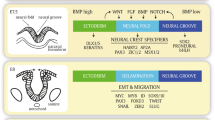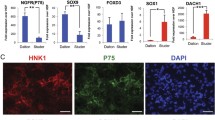Abstract
Neural crest cells (NCCs) comprise a population of multipotent progenitors and stem cells at the origin of the peripheral nervous system (PNS) and melanocytes of skin, which are profoundly influenced by microenvironmental factors, among which is basic fibroblast growth factor 2 (FGF2). In this work, we further investigated the role of this growth factor in quail trunk NC morphogenesis and demonstrated its huge effect in NCC growth mainly by stimulating cell proliferation but also reducing cell death, despite that NCC migration from the neural tube explant was not affected. Moreover, following FGF2 treatment, reduced expression of the early NC markers Sox10 and FoxD3 and improved proliferation of HNK1-positive NCC were observed. Since these markers are involved in the regulation of glial and melanocytic fate of NC, the effect of FGF2 on NCC differentiation was investigated. Therefore, in the presence of FGF2, increased proportions of NCCs positives to the melanoblast marker Mitf as well as NCCs double stained to Mitf and BrdU were recorded. In addition, treatment with FGF2, followed by differentiation medium, resulted in increased expression of melanin and improved proportion of melanin-pigmented melanocytes without alteration in the glial marker Schwann myelin protein (SMP). Taken together, these data further reveal the important role of FGF2 in NCC proliferation, survival, and differentiation, particularly in melanocyte development. This is the first demonstration of FGF2 effects in melanocyte commitment of NC and in the proliferation of Mitf-positive melanoblasts. Elucidating the differentiation process of embryonic NCCs brings us a step closer to understanding the development of the PNS and then undertaking the search for advanced technologies to prevent, or treat, injuries caused by NC-related disorders, also known as neurocristopathies.






Similar content being viewed by others
References
Abo T, Balch CM (1981) A differentiation antigen of human NK and K cells identified by a monoclonal antibody (HNK-1). J Immunol 127:1024–1029
Abzhanov A, Tzahor E, Lassar AB, Tabin CJ (2003) Dissimilar regulation of cell differentiation in mesencephalic (cranial) and sacral (trunk) neural crest cells in vitro. Development 130:4567–4579. https://doi.org/10.1242/dev.00673
Adameyko I, Lallemend F (2010) Glial versus melanocyte cell fate choice: Schwann cell precursors as a cellular origin of melanocytes. Cell Mol Life Sci 67:3037–3055. https://doi.org/10.1007/s00018-010-0390-y
Adameyko I, Lallemend F, Aquino JB et al (2009) Schwann cell precursors from nerve innervation are a cellular origin of melanocytes in skin. Cell 139:366–379. https://doi.org/10.1016/j.cell.2009.07.049
Aquino JB (2017) Uncovering the in vivo source of adult neural crest stem cells. Stem Cells Dev 26:303–313. https://doi.org/10.1089/scd.2016.0297
Aquino JB, Sierra R (2018) Schwann cell precursors in health and disease. Glia 66:465–476. https://doi.org/10.1002/glia.23262
Bittencourt DA, da Costa MC, Calloni GW et al (2013) Fibroblast growth factor 2 promotes the self-renewal of bipotent glial smooth muscle neural crest progenitors. Stem Cells Dev 22:1241–1251. https://doi.org/10.1089/scd.2012.0585
Bressan RB, Melo FR, Almeida PA et al (2014) EGF-FGF2 stimulates the proliferation and improves the neuronal commitment of mouse epidermal neural crest stem cells (EPI-NCSCs). Exp Cell Res 327:37–47. https://doi.org/10.1016/j.yexcr.2014.05.020
Bronner-Fraser M (1986) Analysis of the early stages of trunk neural crest migration in avian embryos using monoclonal antibody HNK-1. Dev Biol 115:44–55. https://doi.org/10.1016/0012-1606(86)90226-5
Calloni GW, Le Douarin NM, Dupin E (2009) High frequency of cephalic neural crest cells shows coexistence of neurogenic, melanogenic, and osteogenic differentiation capacities. Proc Natl Acad Sci USA 106:8947–8952. https://doi.org/10.1073/pnas.0903780106
Coelho-Aguiar JM, Le Douarin NM, Dupin E (2013) Environmental factors unveil dormant developmental capacities in multipotent progenitors of the trunk neural crest. Dev Biol 384:13–25. https://doi.org/10.1016/j.ydbio.2013.09.030
Costa-Silva B, da Costa MC, Melo FR et al (2009) Fibronectin promotes differentiation of neural crest progenitors endowed with smooth muscle cell potential. Exp Cell Res 315:955–967. https://doi.org/10.1016/j.yexcr.2009.01.015
Dulac C, Cameron-Curry P, Ziller C, Le Douarin NM (1988) A surface protein expressed by avian myelinating and nonmyelinating Schwann cells but not by satellite or enteric glial cells. Neuron 1:211–220. https://doi.org/10.1016/0896-6273(88)90141-9
Dupin E, Sommer L (2012) Neural crest progenitors and stem cells: from early development to adulthood. Dev Biol 366:83–95. https://doi.org/10.1016/j.ydbio.2012.02.035
Dupin E, Glavieux C, Vaigot P, Le Douarin NM (2000) Endothelin 3 induces the reversion of melanocytes to glia through a neural crest-derived glial-melanocytic progenitor. Proc Natl Acad Sci USA 97:7882–7887
Dupin E, Real C, Glavieux-Pardanaud C et al (2003) Reversal of developmental restrictions in neural crest lineages: transition from schwann cells to glial-melanocytic precursors in vitro. Proc Natl Acad Sci USA 100:5229–5233. https://doi.org/10.1073/pnas.0831229100
Dupin E, Calloni GW, Coelho-Aguiar JM, Le Douarin NM (2018) The issue of the multipotency of the neural crest cells. Dev Biol. https://doi.org/10.1016/j.ydbio.2018.03.024
Garcez RC, Teixeira BL, Schmitt SDS et al (2009) Epidermal growth factor (EGF) promotes the in vitro differentiation of neural crest cells to neurons and melanocytes. Cell Mol Neurobiol 29:1087–1091. https://doi.org/10.1007/s10571-009-9406-2
Halaban R, Ghosh S, Baird A (1987) bFGF is the putative natural growth factor for human melanocytes. Vitro Cell Dev Biol 23:47–52
Hall BK (2009) The neural crest and neural crest cells in vertebrate development and evolution. Springer, US, Boston, MA
Harris ML, Buac K, Shakhova O et al (2013) A dual role for SOX10 in the maintenance of the postnatal melanocyte lineage and the differentiation of melanocyte stem cell progenitors. PLoS Genet 9:e1003644. https://doi.org/10.1371/journal.pgen.1003644
Hirobe T, Shinpo T, Higuchi K, Sano T (2010) Life cycle of human melanocytes is regulated by endothelin-1 and stem cell factor in synergy with cyclic AMP and basic fibroblast growth factor. J Dermatol Sci 57:123–131. https://doi.org/10.1016/j.jdermsci.2009.11.006
Hochgreb-Hägele T, Bronner ME (2013) A novel FoxD3 gene trap line reveals neural crest precursor movement and a role for FoxD3 in their specification. Dev Biol 374:1–11. https://doi.org/10.1016/j.ydbio.2012.11.035
Kalcheim C (1989) Basic fibroblast growth factor stimulates survival of nonneuronal cells developing from trunk neural crest. Dev Biol 134:1–10
Kim J, Lo L, Dormand E, Anderson DJ (2003) SOX10 maintains multipotency and inhibits neuronal differentiation of neural crest stem cells. Neuron 38:17–31. https://doi.org/10.1016/S0896-6273(03)00163-6
Kubota Y, Ito K (2000) Chemotactic migration of mesencephalic neural crest cells in the mouse. Dev Dyn 217:170–179. https://doi.org/10.1002/(SICI)1097-0177(200002)217:2%3c170:AID-DVDY4%3e3.0.CO;2-9
Kuhlbrodt K, Herbarth B, Sock E et al (1998) Sox10, a novel transcriptional modulator in glial cells. J Neurosci 18:237–250
Lahav R, Dupin E, Lecoin L et al (1998) Endothelin 3 selectively promotes survival and proliferation of neural crest-derived glial and melanocytic precursors in vitro. Proc Natl Acad Sci USA 95:14214–14219
Le Douarin N, Kalcheim C (1999) The neural crest. Cambridge University Press, Cambridge
Levy C, Khaled M, Fisher DE (2006) MITF: master regulator of melanocyte development and melanoma oncogene. Trends Mol Med 12:406–414. https://doi.org/10.1016/j.molmed.2006.07.008
Meier F, Caroli U, Satyamoorthy K et al (2003) Fibroblast growth factor-2 but not Mel-CAM and/or beta3 integrin promotes progression of melanocytes to melanoma. Exp Dermatol 12:296–306
Murphy M, Reid K, Ford M et al (1994) FGF2 regulates proliferation of neural crest cells, with subsequent neuronal differentiation regulated by LIF or related factors. Development 120:3519–3528
Nakanishi K, Chan YS, Ito K (2007) Notch signaling is required for the chondrogenic specification of mouse mesencephalic neural crest cells. Mech Dev 124:190–203. https://doi.org/10.1016/j.mod.2006.12.002
Nesbit M, Nesbit HK, Bennett J et al (1999) Basic fibroblast growth factor induces a transformed phenotype in normal human melanocytes. Oncogene 18:6469–6476. https://doi.org/10.1038/sj.onc.1203066
Nitzan E, Krispin S, Pfaltzgraff ER et al (2013a) A dynamic code of dorsal neural tube genes regulates the segregation between neurogenic and melanogenic neural crest cells. Development 140:2269–2279. https://doi.org/10.1242/dev.093294
Nitzan E, Pfaltzgraff ER, Labosky PA, Kalcheim C (2013b) Neural crest and Schwann cell progenitor-derived melanocytes are two spatially segregated populations similarly regulated by Foxd3. Proc Natl Acad Sci 110:12709–12714. https://doi.org/10.1073/pnas.1306287110
Ota M, Ito K (2006) BMP and FGF-2 regulate neurogenin-2 expression and the differentiation of sensory neurons and glia. Dev Dyn 235:646–655. https://doi.org/10.1002/dvdy.20673
Rizvi TA, Huang Y, Sidani A et al (2002) A novel cytokine pathway suppresses glial cell melanogenesis after injury to adult nerve. J Neurosci 22:9831–9840
Sarkar S, Petiot A, Copp A et al (2001) FGF2 promotes skeletogenic differentiation of cranial neural crest cells. Development 128:2143–2152
Sauka-Spengler T, Bronner-Fraser M (2008) A gene regulatory network orchestrates neural crest formation. Nat Rev Mol Cell Biol 9:557–568. https://doi.org/10.1038/nrm2428
Sommer L (2018) Developmental Biology of Melanocytes. In: Fisher DE, Bastian BC (eds) Melanoma. Springer, New York, pp 1–17
Stocker KM, Sherman L, Rees S, Ciment G (1991) Basic FGF and TGF-beta 1 influence commitment to melanogenesis in neural crest-derived cells of avian embryos. Development 111:635–645
Swope VB, Medrano EE, Smalara D, Abdel-Malek ZA (1995) Long-term proliferation of human melanocytes is supported by the physiologic mitogens alpha-melanotropin, endothelin-1, and basic fibroblast growth factor. Exp Cell Res 217:453–459
Thomas AJ, Erickson CA (2009) FOXD3 regulates the lineage switch between neural crest-derived glial cells and pigment cells by repressing MITF through a non-canonical mechanism. Development 136:1849–1858. https://doi.org/10.1242/dev.031989
Trentin A, Glavieux-Pardanaud C, Le Douarin NM, Dupin E (2004) Self-renewal capacity is a widespread property of various types of neural crest precursor cells. Proc Natl Acad Sci USA 101:4495–4500. https://doi.org/10.1073/pnas.0400629101
Trentin AG, Garcez RC, Bressan RB (2016) Neural crest stem cell cultures: establishment, characterization and potential use. Working with stem cells. Springer International Publishing, Cham, pp 111–125
Tucker GC, Aoyama H, Lipinski M et al (1984) Identical reactivity of monoclonal antibodies HNK-1 and NC-1: conservation in vertebrates on cells derived from the neural primordium and on some leukocytes. Cell Differ 14:223–230
Vincent M, Duband JL, Thiery JP (1983) A cell surface determinant expressed early on migrating avian neural crest cells. Brain Res 285:235–238
Widera D, Heimann P, Zander C et al (2011) Schwann cells can be reprogrammed to multipotency by culture. Stem Cells Dev 20:2053–2064. https://doi.org/10.1089/scd.2010.0525
Zhang J-M, Hoffmann R, Sieber-Blum M (1997) Mitogenic and anti-proliferative signals for neural crest cells and the neurogenic action of TGF-β1. Dev Dyn 208:375–386. https://doi.org/10.1002/(SICI)1097-0177(199703)208:3%3c375:AID-AJA8%3e3.0.CO;2-F
Acknowledgements
This work was supported by the Ministério da Ciência, Tecnologia e Inovação/Conselho Nacional de Desenvolvimento Científico e Tecnológico (MCTI/CNPq/Brazil), Grants 465656/2014-5 and 309128/2013-7 from CNPq, Coordenação de Aperfeiçoamento de Pessoal de Nível Superior—Brasil (CAPES)—Finance Code 001. Bianca L. Teixeira and Diego Amarante-Silva received a fellowship from the Coordenação de Aperfeiçoamento de Pessoal de Nível Superior (CAPES, Brazil). Diego Amarante-Silva also received a fellowship from the Programa de Doutorado Sanduíche no Exterior (PDSE/CAPES) processo BEX 6793-15-0 to develop part of his PhD in the Institut de la Vision—Paris-France. We would like to thank all the staff from the Multiuser Laboratory of Biology Studies (LAMEB/UFSC) for the technical support.
Author information
Authors and Affiliations
Contributions
BLT and DAS are both first authors. BLT, DAS, RCG, and AGT: Conceived and designed the experiments. DAS, BLT, and SBV: Performed experiments. BLT, DAS, and AGT: Analyzed data. BLT, DAS, and AGT: Wrote the manuscript.
Corresponding author
Ethics declarations
Conflict of interest
The authors declare that they have no conflict of interest.
Ethical Approval
All procedures performed in studies involving animals were in accordance with the Animal Ethics Committee of Santa Catarina Federal University, Brazil (protocol number 6016021017).
Additional information
Publisher's Note
Springer Nature remains neutral with regard to jurisdictional claims in published maps and institutional affiliations.
Rights and permissions
About this article
Cite this article
Teixeira, B.L., Amarante-Silva, D., Visoni, S.B. et al. FGF2 Stimulates the Growth and Improves the Melanocytic Commitment of Trunk Neural Crest Cells. Cell Mol Neurobiol 40, 383–393 (2020). https://doi.org/10.1007/s10571-019-00738-9
Received:
Accepted:
Published:
Issue Date:
DOI: https://doi.org/10.1007/s10571-019-00738-9




